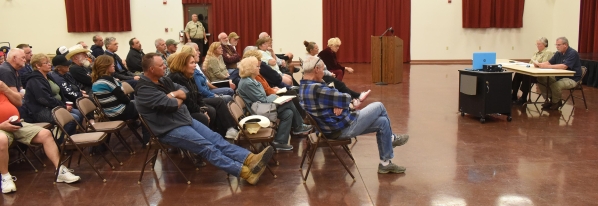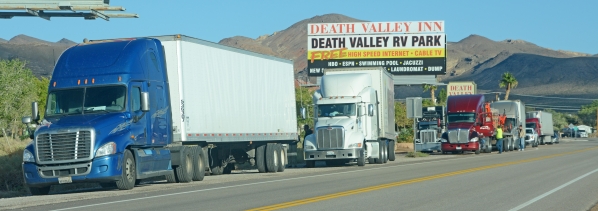Nye sheriff, emergency manager discuss dual events
BEATTY - The Nye County official in charge of emergency management said the combined combination of widespread flash flooding with an industrial fire at a hazardous materials disposal site near Beatty is something he hopes to never see again.
"It was the most challenging, fastest moving event I've ever worked," said Nye County Emergency Management Director Vance Payne. "If I live to be 200, I hope to never see another one."
Payne and Nye County Sheriff Sharon Wehrly held a town hall meeting Tuesday evening in Beatty to inform residents about what had happened and to explain their response.
Payne said that things started with "a pretty significant rain event in Pahrump," which already had them working at 4:30 a.m., and things only got more widespread and demanding.
Both Wehrly and Payne said that so much was going on at once that their resources were pretty well exhausted. They were running out of people to man the roadblocks.
"As soon as we got a road open, the rain would move and we'd have to close one somewhere else," Wehrly said.
The sheriff said she was grateful for all the help they got from other agencies. As an example, she said she was grateful for the help she got from Clark County Sheriff Joseph Lombardo.
She said some people had gotten stranded in a vehicle in floodwaters at Ash Meadows. She had sent two different teams to attempt to reach the people, but both had to turn back because of deep, rushing water.
She called Sheriff Joseph Lombardo of the Las Vegas Metropolitan Police Department, and he sent a helicopter crew that responded and effected the rescue "in the dark of night."
"We are really blessed to have people in this county and around this county who believe in a helping hand," Wehrly said.
As for the highway closures, particularly the lengthy closure of U.S. Highway 95, the sheriff said, "We had to close the highway, not because of US Ecology, but because of the road conditions."
Of the school closures in Beatty and Amargosa, she said, "We didn't close the schools. The rain closed the schools. The school district came to us and said, 'we are closing the schools because we can't run our buses.'"
She said that school officials wanted the children and staff home with their families in case there had to be an evacuation. She also said evacuation plans were in place for Beatty and Amargosa, "but thank God we didn't have to use them."
Payne said that several things in the complex situation turned out to be blessings.
First of these was the rain that forced road closures. He said that gave them time to respond to the emergency at US Ecology without a lot of other people showing up at the scene.
Second, he said that during the fire, the wind never blew toward populated areas, namely Beatty and Amargosa.
And then, he said that the additional closure caused by the fire gave NDOT workers time to make repairs on the highway.
Payne said the fire at US Ecology was in a portion of the site that was the responsibility of the Nevada Department of Health and Human Services and the U.S. Department of Energy.
That part of the site, from before US Ecology began operation there, opened in 1962 and was closed and capped in 1992. Unlike the current operation, it accepted low-level nuclear waste.
US Ecology Beatty Manager Robert Marchand could not be certain what the area that burned contained, because his company does not have records from the previous operator.
Payne and Wehrly took steps to declare a state of emergency, and multiple agencies were called in to help.
Payne praised the response of Governor Sandoval, who he said "made things happen. This is impressive stuff. They really pulled out all the stops to protect you."
Local, state, and federal agencies were involved in the response. Helicopters and planes flew patterns for hours over the area sampling the air and other crews sampled at ground level. As it turned out, no contamination was found. Radioactivity was at the normal background level.
Both Wehrly and Payne apologized for not getting information out to people in the community during the incident.
"When you don't know anything, it's really scary," said Wehrly, "because when there is no information, people start developing their own information." They promised to improve communication in any future incident.
Several residents asked questions or made comments during the meeting.
Jerry Hammes called for "more transparency," and said he would like to see testing for other types of radiation, not just gamma.
Referring to the fire, Hammes said, "After 25 years we get a little water and it blows up, and that concerns me."
Hammes was also not happy with the media coverage the industrial fire got.
"Because of the way the media picked up on this - radiation everywhere - I'm concerned about my property values going down based on perceptions," he complained.
Beatty Water and Sanitation District Manager Rob Shirley wanted to know if there had been any testing of groundwater following the fire. No one knew, but there are test wells in the area.
"Why do we not have an early warning system in this town?" was Cindy Craig's question. Payne said that was a good question. He said that the siren at the old ambulance barn was still operable. What is needed is some source of information residents could go to if the siren was sounded.
One resident, who said she moved to Beatty "because I thought it had good people," said this was confirmed by the actions of residents in caring for people who were stranded in Beatty during the road closures.
Some Beatty residents were sharing their homes with people who had nowhere to go, and some were supplying blankets from hotels to keep people warm.
Fred Summers, who operates the Happy Burro, said the people who were stranded were exceptionally nice, too.
"If people are ever stranded here again," he said, "I want the same ones!"


















